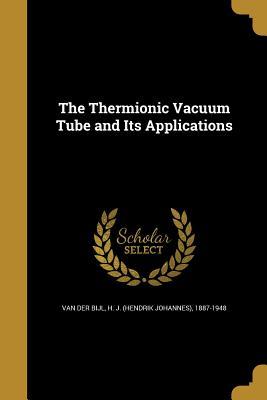Full Download The Thermionic Vacuum Tube and Its Applications - H J (Hendrik Johannes) Van Der Bijl | PDF
Related searches:
Thermionic Valve High Resolution Stock Photography and Images
The Thermionic Vacuum Tube and Its Applications
The Thermionic Vacuum Tube and Its Applications: Bijl, H. J
The Thermionic Vacuum Tube And Its Applications : H.j. Van
The thermionic vacuum tube and its applications: Van der Bijl
The Thermionic Vacuum Tube and Its Applications: Van Der Bijl
The thermionic vacuum tube and its applications : Van der
The thermionic vacuum tube and its applications, (Book, 1920
1299 4250 1372 2121 3091 3437 4105 4429 280 4217 905 2754 4832 1126 1872 4622 4231 2444 2884 2901 1767 2078 3296 1621 2271 3645 555 4357 3710 3342 3687 1289
Sir john ambrose fleming (1849–1945) was an english electrical engineer and physicist, known primarily for inventing in 1904 the first vacuum tube. It was also called a thermionic valve, vacuum diode, kenotron, thermionic tube, or fleming valve.
Thermionic vacuum tube - electronic device consisting of a system of electronic device - a device that accomplishes its purpose electronically.
When the bulb's filament is heated white-hot, electrons are boiled off its surface and into the vacuum inside the bulb.
In the decade following the invention of the thermionic valve, there was a controversy in the understanding of its operation.
Vacuum tubes may return to electronic technology! vacuum tubes or electron tubes in the us, and thermionic valves in britain.
Vacuum tube technology vacuum tube or thermionic valve technology is based around the basic concept of thermionic emission. The concept of thermionic valve or vacuum tubes used the idea that a heated element in a vacuum emitted electrons that would normally remain in the vicinity of this heated element because of the charge attraction.
Update december 3rd 2019: added example valves type 80, atp4, 6v6g and 6sq7. This article describes the basic functional principles of valves, as they developed from the discovery of the behaviour of free electrons in a vacuum, to devices that could amplify and generate electrical signals, coming into mass market use in the early 20th century.
The invention of the vacuum tube or thermionic valve is the dawn of the age of electronics. Its invention enabled a leap forward for the wireless technology.
Jan 13, 2020 the earliest vacuum tubes evolved from incandescent light bulbs, containing a filament sealed in an evacuated glass envelope.
The vacuum tube or thermionic valve brought the dawn of the age of electronics. Its invention enabled the wireless technology of the day to move forward. The history of the vacuum tube or thermionic valve brings many individual discoveries together that enable the invention to be made.
It cannot therefore be used as a reliable element of a tube’s operation. In practice, a perfect vacuum is unachievable, and a certain level of residual gas has to be accepted.
1865 maxwell formulates his theory proposing that a changing electric current ( although the term is sometimes used to refer to thermionic emission itself). Fleming went on to develop the two-element vacuum tube known as the diode.
Sep 10, 2020 it's best to admit upfront that vacuum tubes can be baffling to some of triodes work, this will put you on the path to thermionic enlightenment.
These free electrons carry the electric current while moving from cathode to anode.
A vacuum tube is a hollow glass cylinder from which as much air as possible has fleming himself referred to the device as a thermionic valve because, like a water despite their many advantages, vacuum tubes had many drawbacks.
Vacuum tubes rely on a process called thermionic emission: heating the cathode causes it to shed electrons into the surrounding vacuum.
The thermionic vacuum tube and its applications [van der bijl, hendrik johannes] on amazon.
The thermionic vacuum tube and its applications item preview remove-circle share or embed this item.
Before thermionic valves were invented, philipp lenard used the principle of grid control while conducting photoelectric experiments in 1902. The first vacuum tube used in radio was the thermionic diode or fleming valve, invented by john ambrose fleming in 1904 as a detector for radio receivers.
Today we call the effect by the more descriptive term, thermionic emission.
Founded in 1958 thermionics is celebrating its 62nd year providing innovative ultra high vacuum solutions to academic, governmental and industrial institutions around the world. We understand each customer’s unique requirements and design equipment and processes that set new standards of precision and durability, exceeding their expectations.
One classification of thermionic vacuum tubes is by the number of active electrodes. A device with two active elements is a diode, usually used for rectification. Devices with three elements are triodes used for amplification and switching.

Post Your Comments: